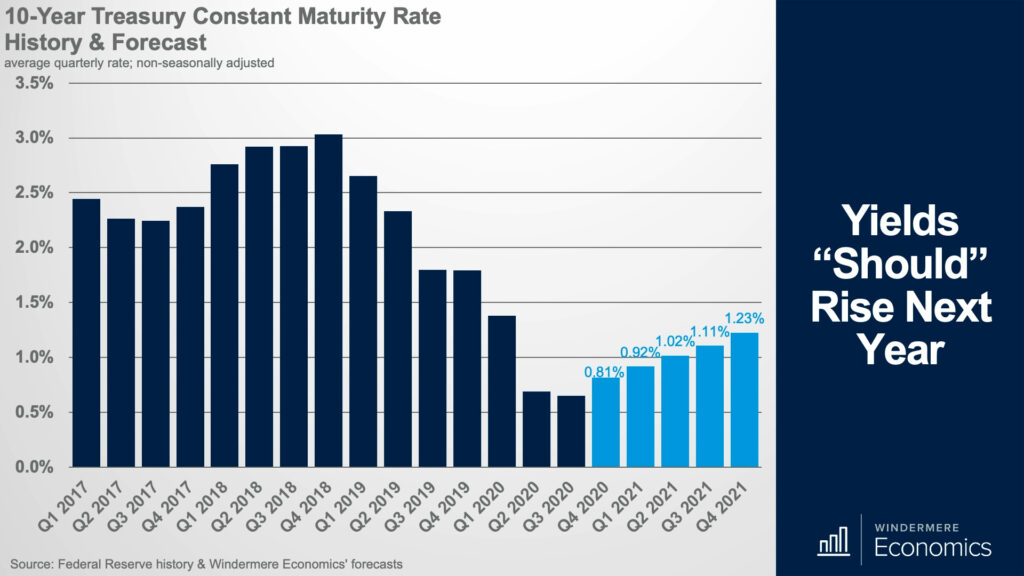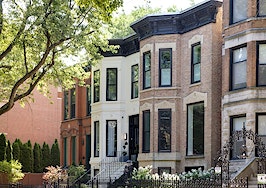There’s an overwhelming amount of data and headlines circulating. This column is my attempt to make sense of it all for you, the real estate professional, from an overall economic standpoint.
After many, many late nights poring over spreadsheets, I am now ready to share my 2021 U.S. housing forecast with you, so without further ado, let’s get to it.
Mortgages
Let’s start with my mortgage rate forecast.
As you are likely aware, we have spent the entire year watching mortgage rates break record lows almost every week, which, along with other factors, has helped drive housing demand significantly higher, but how low can rates go?
My forecast suggests that rates will likely bottom out in the current quarter, but that said, I do not anticipate them rising much as we move through 2021.

Now, I always like to see how my forecasts compare to others, so I spoke with a few housing economists across the country to see where they were regarding rates, and — as you can see — we are all in a pretty tight range for next year. I will tell you that my friends over at Fannie Mae were pretty defensive about their very optimistic forecast — I guess that we will see.
And looking further out, the brave souls who are putting out forecasts for 2022 are showing rates not moving much higher even then, with Fannie Mae at an average of 2.9 percent, Wells Fargo at 3.1 percent and the Mortgage Bankers Association a little higher at 3.6 percent.

The bottom line here is that we are all pretty confident that though rates will start to rise, the increase will be modest, and I personally don’t see it impacting housing demand at all.

And to explain why we will see rates rise, 30-year, fixed-rate mortgages are pretty directly correlated with the yield on 10-year treasuries. You can see here that my forecast shows these rising — albeit modestly — next year, and if this occurs, rates will follow.
But there are two reasons that might stop rates from rising — at least by too much, even if treasury yields do head higher. First is the COVID-19 vaccine. You see, if it takes longer to distribute, or if we chose not to take it, then the economy could take another dip. If that happens, treasury yields will likely pull back, and rates could drop again. But I remain hopeful that this will not be the case.
And second is the Fed. As long as it continues to buy mortgage-backed securities, rates are insulated from rising treasury yields.
Home sales
Let’s take a look at existing homes. My forecast is for sales this year to have risen by 3.9 percent, but sales in 2021 should be up by 6.9 percent, and that’s a level we haven’t seen since 2006.

But for sales to rise to this extent, we need more inventory, and I expect to see more listings next year. And that will likely be, at least partially, due to COVID-19. With some household members’ new abilities to work from home, removing the need to live close to their offices. But there will be others who will move simply because their current homes simply aren’t set up for remote working.
Although I see many homeowners moving due to work-from-home, I believe that many of them will not move that far away. In my opinion, the theory that we will all be working from home full-time is likely overblown, and I would contend that a lot of people will end up blending their workweek with some days at home and some days at their offices. If I am correct, I see many households still staying within reasonable proximity of their workplaces.
Sales prices
Turning our attention now to sale prices, this year has been impressive so far, and we should see sale prices in 2020 ending up 7.4 percent higher than we saw in 2019. This number is quite remarkable, and I say this because I took a look at the 2020 forecast I put out last year, and I was forecasting price growth closer to 4 percent than 7 percent.

But COVID-19 changed all that. Mortgage rates dropped, households decided for several reasons to move, and, in concert with a historically low level of homes available to buy, prices have risen significantly.
Now, as I have said for years, there must always be a relationship between incomes and home prices, and mortgage rates dropping can only allow prices to rise by so much.
Along with other factors, it’s partly due to affordability issues that I see prices rising by a more modest 4.1 percent in 2021.
New home sales
Let’s look now at the new home market. For this discussion, I am just looking at the single-family market. So far this year, we have seen a significant jump in new home sales, and this very robust demand has encouraged builders to start the construction of more homes. My forecast for single-family housing starts shows them rising by 8 percent this year, but next year I see starts up by a very significant 16.4 percent.

This is good news for several reasons, the biggest of which is that more new construction will add to supply, and that should take some of the demand and price pressure off the resale market.
And with more starts, I expect to see sales rising with an increase of 21.5 percent this year and a further 18.7 percent in 2021. Notably, this will put new home sales at a level again that we haven’t seen since 2006.

But I do have one concern regarding the new home market, and my worry is all about cost.
Builders want to do what they do best, and that’s build homes, but they have to reconcile the costs to build a house — which are incredibly high today — with the prices that would-be buyers can afford.
I see them managing this issue by looking to areas where land is cheaper and where there is still demand from buyers who, as we just talked about, are now looking at markets further away from major job centers.
The bottom line is that the new construction market will see very solid gains next year.
Forbearance
And finally, I would be remiss if I didn’t address the one thing that is troubling a lot of brokers and their clients, and that’s forbearance.
Although we saw a modest uptick in active forbearance plans earlier last month, I think it’s important to put things in perspective.
Despite small increases in the number of homes we saw entering the program, the number of active forbearances is still down by 8 percent (or 246,000 homes) from the end of October.

In total, as of Nov. 30, there are 2.76 million homeowners in active forbearance plans, and that represents approximately 5.2 percent of all mortgages. For perspective, the number of homeowners in forbearance is down by almost 2 million from its peak back in May. That’s a drop of 42 percent.
So, let’s talk about this for a bit.
As is human nature, there are some out there predicting that the housing market will crash again purely because of the number of owners in forbearance — all 2.76 million of them — will be foreclosed on when forbearance ends next spring. This flood of foreclosed homes will lead to a spike in supply, which will lead prices to drop like in 2008.
I understand the theory, and I guess that you might say that it seems plausible at face value, but is it?
Although there’s no getting around the fact that foreclosures will rise next year as forbearance terms end, will it really be that dramatic?
I think not. And there are several reasons I’m not overly pessimistic about this.
Although I see foreclosures rising next year, I expect the numbers to be very mild compared to the carnage we saw between 2008 and 2010.
Why do I think this?
Well, the housing bubble burst for very different reasons than we are currently experiencing. Back then, there was a frenzy of reckless lending, irresponsible borrowing and unbridled speculation that did nothing more than set the housing market up for a crash. And crash it did. Home prices collapsed, and millions lost their homes.
But back in March of this year — when COVID-19 kicked in — homeowners were actually in a good place. Credit standards were still very tight, down payments were significant, and the housing market, along with the economy as a whole, was extremely healthy. That’s the difference.
The COVID-19 pandemic has primarily hit renters, but it has impacted a lot of homeowners, too. As the housing market muscles its way through the current economic downturn, I see foreclosures forming more of a trickle rather than a flood.
To support this, my colleagues over at Attom Data Solutions are currently forecasting more than 200,000 homeowners are likely to default next year. Still, if there is a longer-term, coronavirus-related slowdown in the economy, the foreclosure count could get as high as 500,000 homes.
But as dramatic as the projections might seem, it’s worth noting a few things.
- During the Great Recession, foreclosure filings spiked, with 1.65 million American homes going into foreclosure in the first half of 2010. But this is well above the most pessimistic forecasts for foreclosures next year, and even if defaults rise dramatically, they’ll still come in well below the levels we saw following the bursting of the housing bubble.
- As I talked about earlier, home prices have risen steadily since 2012, and homeowners have built up large equity reserves, which is the total opposite of the situation we saw in 2008. Because home values have been rising, many borrowers in forbearance will be able to escape foreclosure by merely selling. We know that there is more than enough demand, and they will sell to make sure that they get the equity out of their homes rather than potentially lose it because of foreclosure.
- Lenders have no stomach for a repeat of the foreclosure crisis we saw back in 2008. Today, I am seeing lenders positioning themselves to use a more-cooperative, less-punitive approach to delinquent borrowers, which will do a better job of keeping people in homes.
- Many, but not all, of the owners in forbearance will not enter foreclosure because they will be able to catch up on their past-due amounts by paying more each month, and some may be allowed to add the past-due amount to the end of the mortgage by lengthening its term.
The bottom line is that the housing market, and homeowners, are in a much better position today than they were in the bubble days. Homeowners today have far more options to avoid foreclosure, and equity is undoubtedly helping to keep many afloat.
Put it this way, even if today’s rate of foreclosures doubles, it will still only hit a mark that’s more in line with a historically normalized range.
Ultimately, I’m not concerned that we will see the housing market collapse because of forbearance.
Final thoughts
And finally, a few more nuggets to think about:
Housing bubble burst
Even if we ignore concerns over forbearance, there are still some talking about a housing bubble purely because prices have risen so rapidly over the past several years. Still, I, along with my colleagues, just don’t see it. Prices have indeed been growing at above-average rates, but fundamentals are still in place. As I mentioned earlier, borrowers are well qualified, and they have solid equity in their homes.
But as I have shown you, price growth is set to slow. I think that because of this slowdown in price increases, there will surely be some homeowners who will believe that the market has collapsed just because real estate agents aren’t telling them what they want to hear as far as the value of their home is concerned. What they need to understand is that the market isn’t collapsing; it’s just normalizing.
Sellers have had the upper hand for a very long time now, and many might have forgotten how a normal housing market looks.
Mass migration
In the early days of the pandemic, buyers did indeed gravitate toward the suburbs. I know this because 57 percent of buyers who bought between April and June of this year chose suburban locations, compared to 50 percent before the pandemic.
But it’s hardly the exodus from cities that some had speculated. I would also note that there was even a small uptick in urban home purchases in that three-month period — 12 percent before the pandemic and 14 percent after. Meanwhile, sales fell a little in small towns and rural areas in the same timeframe, so I do not anticipate a massive move to the countryside.
Yes! You’ve heard this from me for a long time now. First-time buyers will be a significant force again this year — and for years to come — brokers need to figure out how to work with them. Their numbers are only going to grow.

Condos
I don’t see the condo market collapsing across the country — though I see significant issues in markets like Manhattan and San Francisco. I see inventory levels rise fairly significantly as opposed to single-family homes. But, for now, there still appears to be demand as sales are higher, too.
My concern is with the urban condominium market. You see, for many, the primary reasons to buy a downtown condo are twofold — convenient access to work and lifestyle.
Some won’t have to live close to work if they are working from home. Secondly, if we lose some of the lifestyle reasons to live in a city, as we have in the wake of COVID (restaurants, retail and the like), that takes away some of the rationales behind buying a downtown condo.
There’s no need to panic yet, but I will be watching urban condo markets to see if demand continues to keep up with rising supply. If it doesn’t, then we might well see prices softening.
So, there you have it — my 2021 U.S. housing forecast. We made it through 2020.
To get the big picture including all of the data, watch the full video above.
Matthew Gardner is the chief economist for Windermere Real Estate, the second largest regional real estate company in the nation.









